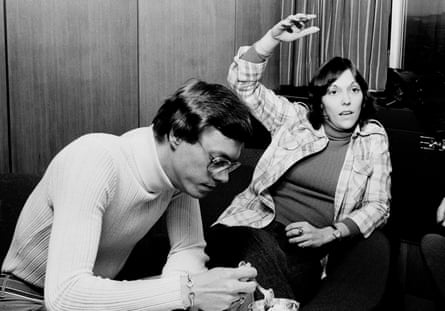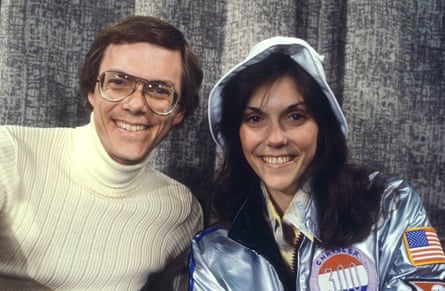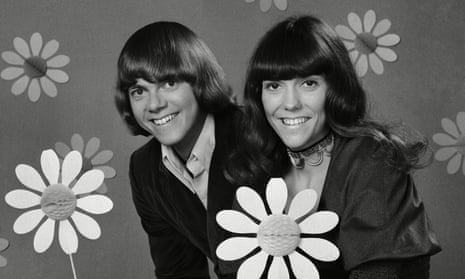1. Looking for Love
The Carpenter family moved from New Haven, Connecticut, to Downey in Los Angeles in 1963, to pursue the starry ambitions of musical child prodigy Richard. His sister Karen had little interest in music, but turned out to be an excellent drummer when she began playing the instrument in favour of the glockenspiel in the school band. While the all-American siblings’ oeuvre was polished, they made a few false starts before they arrived at pop perfection. The Richard Carpenter Trio won a battle of the bands at the Hollywood Bowl but little else. Then came Spectrum, the band in which Richard wrote many of the Carpenters’ future hits with John Bettis, often during downtime while they worked at Disneyland. One curio, Looking for Love, was recorded in a garage lockup owned by Wrecking Crew bassist Joe Osborn, who signed Karen to his Magic Lamp label. The song wasn’t a hit, and Magic Lamp soon ceased trading, but the song – sung by Karen, written by Richard – was the pair’s first real foray into the recording business. With its skittering rhythm section, part provided by Karen, and its proto-psychedelic flute, it’s very different from the Carpenters’ sound in the 70s, but the melody is strong, and so too is 16-year-old Karen’s old-before-its-time voice. The masters were destroyed in a fire at Osborn’s house in 1974, with the recording being reissued from a copy of the 45 owned by Richard. Copies of the original change hands for up to £2,000.
2. Eve
Finally signed to A&M by Herb Alpert, the Carpenters released Offering, their first album as a duo, in 1969. A wayward collection of musically divergent numbers, with vocals shared equally by the siblings, it featured easy-listening kitsch, elevator jazz and numbers that wouldn’t have sounded out of place in the musical Hair. It was a commercial and critical flop on its initial release. There are moments that hint at what was to come, though, namely Someday, Ticket to Ride (their Lennon and McCartney tribute, which charted modestly) and Eve, a standout power ballad by Carpenter and Bettis that wouldn’t have sounded out of place on any of the future albums. The song starts with a plodding, plaintive piano and Karen’s rich alto, before she drum-rolls in and takes things up a notch. Richard’s chops as an arranger come to the fore in the second verse when his accompanying harpsichord takes the emotive ballad into the realms of baroque pop. Although it would be unfair to say Karen struggles with the higher notes, she’s clearly more at ease in the lower register – what her voice lacks in range, it makes up for in raw, demonstrative soul. Karen apparently always considered herself a drummer who sang, discovering she had a captivating voice only when a music teacher told her to try singing an octave lower.

3. (They Long to Be) Close to You
Richard’s genius as an arranger is evident on (They Long to Be) Close to You, a song offered to Alpert by Burt Bacharach, which he suggested his proteges cover because he didn’t want to sing the words “moondust in your hair” himself. It had been recorded by the actor Richard Chamberlain and had also been a Dionne Warwick B-side from 1965. Listen to the Warwick version and you’ll notice the syncopation, featuring airy staccato plinks, rather elongates the phrasing. Richard decided to try it with a punchier, swinging groove and – voilà! – the duo had their first US No 1. Bacharach conceded that the reimagining was exactly what his song needed. Incidentally, many assume the flugelhorn solo is by Alpert, but he was unavailable and Chuck Findley was drafted in to imitate the distinctive style of the Tijuana-brass legend.
4. Rainy Days and Mondays
The Carpenters’ next big hit – We’ve Only Just Begun –started life as a bank commercial, written by A&M in-house writing team Paul Williams and Roger Nichols. Soon the Carpenters had their second million-seller and a pair of Grammys followed. The duo stuck with Williams and Nichols for 1971’s Rainy Days and Mondays, a song that showcases Karen’s gift for conveying pathos as the poster girl for suburban noir. A&M once championed the Carpenters’ “wholesome image and natural, unpretentious personalities” in a press release, and claimed their music heralded the “three Hs ... hope, happiness, harmony”. In truth, they probably channeled the fives Bs – the Beach Boys, Burt Bacharach and the Beatles – but Richard’s arrangements and Karen’s voice provided an edge not immediately apparent in the music. The combination of her rich, depressed mezzo and lyrics such as “What I’ve got they used to call the blues” combine to create a three-and-a-half-minute hit with considerable emotional heft, especially from such a folksy duo accused of peddling instant nostalgia.
5. Superstar
Of all the Carpenters songs, Superstar is the raunchiest, and possibly the most melancholic, too. Sung from the perspective of a fan – the original by Delaney and Bonnie was called Groupie (Superstar) – the implication is that the singer has either been duped or is delusional about a romantic connection with a pop idol. Certainly the chorus (“Don’t you remember you told me you loved me, baby? / You said you’d be coming back this way again, baby”) would be almost comical sung by anyone other than Karen, and the insistent “Baby, baby, baby, baby, oh, baby, I love you I really do” would add a whiff of desperation if she didn’t sound so world-weary and haunted. The track originally featured the risque line, “And I can hardly wait to sleep with you again”, which Richard changed to “be with you again”, ensuring plenty of airplay (although the suggestive “What to say to make you come again” stayed). The song was written by Bonnie Bramlett and Leon Russell, but it’s fair to say the Carpenters owned it with their version. Sonic Youth covered it memorably on a tribute album to the duo in 1994 called If I Were a Carpenter, although Richard is reported to have said he didn’t care for their update.
6. Goodbye to Love
Another original Carpenter/Bettis composition – the inspiration came from an imaginary song in a 1940 Bing Crosby movie, Rhythm on the River – Goodbye to Love is alluded to but we never hear it. Richard decided to write that song, featuring a lyric (“No one ever cared if I should live or die / Time and time again the chance for love has passed me by”) that wouldn’t have sounded out of place in a Smiths song. Released in 1972, it features a guitar solo from Tony Peluso that burns. Back when music made with guitar, bass and drums was considered to be the only sound of authenticity and bands were supposed to pay their dues, the Carpenters were anathema to high-minded rock fans – a vaporising solo in the middle of a pop soufflé caused much consternation then. “The start of my appreciation of the Carpenters was hearing Goodbye to Love,” wrote journalist John Tobler, “[and] what made it so astonishing for me was the guitar solo towards the end of the record, which could easily have been played by some progressive hero of the ilk of Jimmy Page or Jeff Beck.” A few years later, attitudes had changed slightly. Writing in Photograph Record, Ken Barnes said: “It’s certainly less than revolutionary to admit you like the Carpenters these days – in ‘rock’ circles, if you recall, it formerly bordered on heresy. Everybody must be won over by now.”
7. Yesterday Once More
In 1973, the duo tried to shake up the formula by bringing back Karen on drums for the album Now & Then. She hadn’t played on record since Offering, although she did play many of the pacier numbers live. As reformations go, it was hardly earth-shattering. The pair were still releasing melodic, melancholy ballads pitched at 50 beats per minute, and Yesterday Once More, with its titular nod to the past, practically acknowledged that the Carpenters were in the business of instant classics. On the single version, Karen manages to make “every shing-a-ling-ling that they’re starting to sing” sound heartbreaking, but the 18-and-a-half minute medley on the B-side of Now & Then featuring Da Doo Ron Ron, Night of a Thousand Eyes and Fun, Fun, Fun is all kinds of wrong. Yesterday Once More is reputedly Richard’s favourite self-composition and with good reason. It’s terrific, but otherwise the duo were in danger of becoming a self-parody. They took 1974 off.

8. Only Yesterday
Another day, another song with Yesterday in the title, though Only Yesterday was ambitious in scope, taking in various codas, and featuring a rhythm track that starts like a Ronettes classic and peaks in the chorus with clattering castanets. The song also starts with Karen singing from her boots, her voice climbing steadily as the song progresses. The verses explore gripes about solitude, though there’s a glimmer of hope that “baby baby / feels like maybe / things will be all right”. The track was the last Carpenter/Bettis composition to trouble the Billboard’s top 10, with Richard complaining it was “no fun writing between tours. Just real hard work ... What we did turn out did well, but we were definitely not prolific.”
9. B’wana She No Home
Stung by criticism of the band’s undercooked A Kind of Hush, which Richard later admitted was below par due to his dependence on prescription drugs, the band brought out their most experimental album Passage in 1977. It was an expansive collection of unexpected versions of other people’s songs, while production duties were again taken care of by Richard, who claimed he couldn’t get anyone else to sign on. Opener B’wana She No Home, written by jazz singer Michael Franks, was, according to one critic, “Karen trying to answer criticism that she is so white she is invisible”. While derided at the time, fresh ears suggest B’wana She No Home is a worthy addition to the Carpenters’ canon, bold and unusually danceable, with a smattering of conga and percussion to give it some pep. It’s the sound of session musicians being set free and often errs into dark places, but it always manages to remain in the vicinity of good taste.
10. Calling Occupants of Interplanetary Craft (The Recognised Anthem of World Contact Day)
Calling Occupants is perhaps the Carpenters’ last great triumph on single, although anyone who has never heard it before is advised to skip the first 50 seconds, which features a “comedy” skit between an extraterrestrial and a Californian disc jockey who uses the word “babe” too often. What follows though is six minutes of out-of-this-world magnificence, musically out of step as ever with what was going on in 1977, but oddly anticipating the sudden appetite for science fiction precipitated by Close Encounters of the Third Kind and Star Wars. The cover of Klaatu’s bizarre sci-fi ballad about an intergalactic intervention from an “interstellar policeman” apparently features up to 160 musicians and singers, and listening to it wax and wane and transmogrify, it’s not difficult to imagine that is indeed the case. If you can ignore the blunder at the outset, then the remaining six minutes might well be Richard Carpenter’s masterpiece. Taking the critics to heart once more, the Carpenters would never dare to be this adventurous again – a tragedy, although obviously there were worse tragedies to come.

Comments (…)
Sign in or create your Guardian account to join the discussion